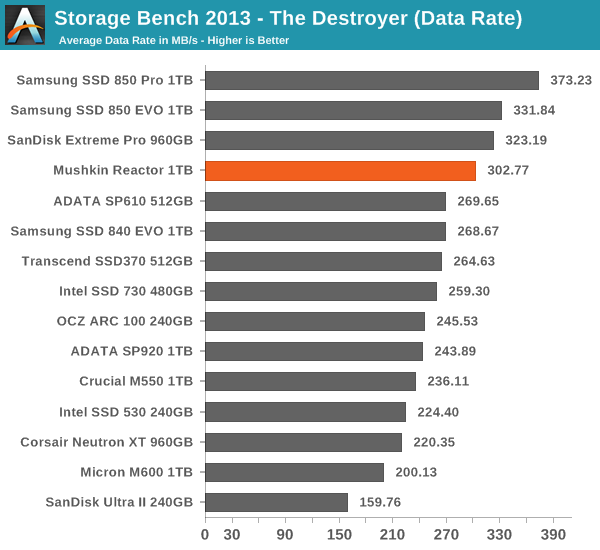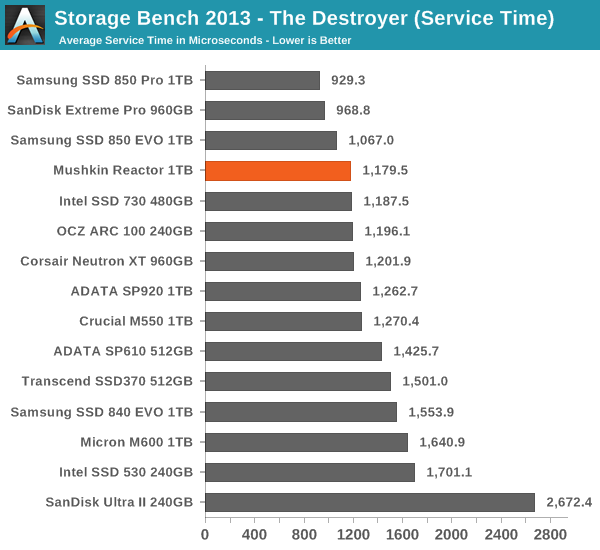Mushkin Reactor 1TB SSD Review
by Kristian Vättö on February 9, 2015 11:32 AM EST- Posted in
- Storage
- SSDs
- Mushkin
- Silicon Motion
- SM2246EN
- Reactor
- Micron 16nm
AnandTech Storage Bench 2013
Our Storage Bench 2013 focuses on worst-case multitasking and IO consistency. Similar to our earlier Storage Benches, the test is still application trace based – we record all IO requests made to a test system and play them back on the drive we are testing and run statistical analysis on the drive's responses. There are 49.8 million IO operations in total with 1583.0GB of reads and 875.6GB of writes. I'm not including the full description of the test for better readability, so make sure to read our Storage Bench 2013 introduction for the full details.
| AnandTech Storage Bench 2013 - The Destroyer | ||
| Workload | Description | Applications Used |
| Photo Sync/Editing | Import images, edit, export | Adobe Photoshop CS6, Adobe Lightroom 4, Dropbox |
| Gaming | Download/install games, play games | Steam, Deus Ex, Skyrim, Starcraft 2, BioShock Infinite |
| Virtualization | Run/manage VM, use general apps inside VM | VirtualBox |
| General Productivity | Browse the web, manage local email, copy files, encrypt/decrypt files, backup system, download content, virus/malware scan | Chrome, IE10, Outlook, Windows 8, AxCrypt, uTorrent, AdAware |
| Video Playback | Copy and watch movies | Windows 8 |
| Application Development | Compile projects, check out code, download code samples | Visual Studio 2012 |
We are reporting two primary metrics with the Destroyer: average data rate in MB/s and average service time in microseconds. The former gives you an idea of the throughput of the drive during the time that it was running the test workload. This can be a very good indication of overall performance. What average data rate doesn't do a good job of is taking into account response time of very bursty (read: high queue depth) IO. By reporting average service time we heavily weigh latency for queued IOs. You'll note that this is a metric we have been reporting in our enterprise benchmarks for a while now. With the client tests maturing, the time was right for a little convergence.

The Reactor does very well in our 2013 Storage Bench and is only beaten by the more expensive SanDisk and Samsung. Among the more value-oriented 1TB SSDs, the Reactor seems to be taking the lead.











69 Comments
View All Comments
Hulk - Monday, February 9, 2015 - link
When it's written as 131GB writes/day for 3 years it seems like more than enough.But cell endurance of 144 writes seems really, really low.
hojnikb - Monday, February 9, 2015 - link
It doesnt work like that. 144TB for 1TB doesn't translate to 144 p/e flash. You have to factor in write amplification, which can be more than 1 on controller like this.Also conservative rating is nothing new with budget driver.
cm2187 - Friday, February 13, 2015 - link
Stupid question: has anyone any experience with SSD reliability over time. I.e. is it reliable to store static data 3-5y+? Or does the 3y (or 5y) guarantee also means the data should be migrated out after that period even if the number of writes has been low?hojnikb - Monday, February 9, 2015 - link
Its just a conservative rating for warranty purposes. Besides, other value drives are no better at this (evo is only "good" for 150TB).In reality, drives typically last many times the rated endurance.
DanNeely - Monday, February 9, 2015 - link
More importantly, it's set low to scare off enterprise customers who'd subject the drive to an order of magnitude more IO.toyotabedzrock - Monday, February 9, 2015 - link
So if the endurance is 144TB on a 1TB drive, they are predicting the nand can only take 144 writes?That is a bit scary for even home use. I wouldn't trust my data to that.
zepi - Monday, February 9, 2015 - link
There is not a single medium or drive out there that you should trust your data on. Only thing you can trust is redundancy.hojnikb - Monday, February 9, 2015 - link
No. Read my post above ^^TheinsanegamerN - Monday, February 9, 2015 - link
the 512GB crusial mx 100 endurance is only 72TB, yet people dont seem to be complaining. besides, as typical day to day use only accounts for maybe ~10GB or writes(3.65TB a year), the 144TB endurance will last far longer than the machine it is put in.Murloc - Monday, February 9, 2015 - link
yeah problem is that until it's broken, I'll keep moving it on to the next machine.But I write about 1 GB/week to the SSD so I should be safe, unless windows does a lot of that in the background, I don't know, I just deactivated all the bad stuff I read about.